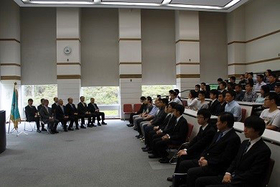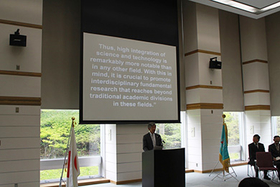2016/10/05
On Monday, October 3, 2016, the fall entrance ceremony was held in the Training Hall on the 1st floor of Interdisciplinary Frontier Research Complex No.2.
NAIST eagerly promotes admission of students from both Japan and overseas with strong basic academic capabilities without being bound to traditional fields of university studies as well as researchers, engineers and others currently working actively in society who have clearly defined goals and aspirations for the future as well as strong interest and enthusiasm for research. This autumn 65 graduate students were granted admission to NAIST.
*Number of Enrollees in October
【Master's Course】
Information Science 19 (16 international students)
Biological Sciences 7 (7 international students)
Materials Science 6 (6 international students)
【Doctoral Course】
Information Science 14 (9 international students)
Biological Sciences 11 (11 international students)
Materials Science 8 (7 international students)
Total 65 (56 international students)
Congratulatory Remarks to Entering Students
October 3, 2016
I would like to express my heartfelt congratulations to the 32 students entering the master's courses and the 33 new and continuing students entering the doctoral courses of NAIST today. On behalf of the faculty and staff members here at NAIST, I welcome you.
I am pleased to announce that the incoming class includes 56 international students from 11 countries / regions. In particular, I would like to express a warm welcome to those of you who have chosen to leave your home country and study in Japan.Including the entering class today, we now have 214 international students from 30 countries / regions, accounting for a total of 20% of our 1,071 student population.
Now, I would like to explain to the new students the background of the foundation of NAIST. In the concept paper concerning NAIST's establishment, the guiding mission of our research is described as:
"Characteristically, the fields of frontier science and technology have wide-ranging, interdisciplinary dimensions in which innovative developments are taking place at a very rapid pace. In these fields, new knowledge from fundamental research results in technological developments in very short periods, and technological developments, in turn, become the base of fundamental research and make further progress possible. Thus, high integration of science and technology is remarkably more notable than in any other field. With this in mind, it is crucial to promote interdisciplinary fundamental research that reaches beyond traditional academic divisions in these fields."
The education mission of NAIST is explained as follows.
"With the rapid developments in the areas of frontier science and technology, an important issue for both academic research and industry is the organized fostering of researchers and engineers capable of undertaking research and development in these fields. Especially in these fields, it is necessary to train diverse human resources with refined fundamental skills to respond flexibly to developments in science and technology, and to continuously pursue new fields of research."
To sum up, NAIST was founded to conduct interdisciplinary research in rapidly developing fields of frontier science and technology such as information, biological and materials sciences, by integrating science and technology and extending beyond the borders of established study areas such as engineering, physical science, agriculture and medical science. With this as our foundation, NAIST develops human resources capable of flexibly responding to developments in science and technology, and continually cultivating new areas of research. NAIST's education and research mission, which has since been revised to include the keyword "to see [issues] from a global perspective," was pioneering from the outset and continues to represent the ideas necessary for society today.
With dynamic research by faculty members from various backgrounds, and through organized graduate school education based on cutting-edge research, NAIST has produced 6,929 master's and 1,336 doctoral graduates. Of these graduates, there are 449 that came from 58 countries around the world. NAIST sees its role of building a global network for research and human resource development centered upon these graduates that are active worldwide as essential. In order to further expand and strengthen this network, NAIST opened its overseas office in Indonesia in April and we are currently moving forward with plans to establish the next office in Thailand.
NAIST's research and educational activities have been evaluated very highly. For example, MEXT is now offering extensive support to 22 Japanese institutions with a track record of outstanding research under its Program for Promoting the Enhancement of Research Universities in order to strengthen research prowess. NAIST was one of the institutions chosen.
In addition, Japanese universities have tended to focus domestically, but today we must internationalize ourselves with a view to the future of the world, so that more students and researchers from around the world will study at Japanese universities and learn about Japanese science and technology, while Japanese students need to be exposed to the demands placed on science and technology at the global level and to the societies of various countries. For this, MEXT is promoting a program called the Top Global University Project. This project is designed to provide priority support for selected universities that focus on increasing their international competitiveness, and I am pleased to note that NAIST is a participating university.
I am proud to add that we are one of only 17 Japanese universities selected for both the Program for Promoting the Enhancement of Research Universities and the Top Global University Project. You should be proud of being members of one of the most prestigious universities in Japan in terms of both research and education, and I urge you to take advantage of the precious opportunities available at NAIST.
We are now facing drastic changes in science and technology and are said to be in the middle of a new revolution in science and technology. Although information, biological, and materials sciences are the basis of today's science and technology, these areas and their research are developing significantly.
New keywords for information science are big data, Internet of Things (IoT) and artificial intelligence. Thanks to computer, sensor and network efficiency improvement, the entire world is now interconnected in real time through the internet, and integrated data use around the world is now possible. We can also see the rise of a 'Super Smart Society' which integrates the 'cyber world' and the 'real world' through networks connecting everything around us to effectively and thoroughly respond to the various needs of society in offering the necessary materials or services to the necessary people at the necessary time in the necessary amount.
Within biosciences, revolutions in areas such as genome DNA sequence analysis technology and cellular activity imaging technology have allowed us to collect huge amounts of data on the activities of various cells and living organisms within nature, including humans.
In material science as well, progress in analysis and measurement technology has uncovered a new world of materials and with the elucidation of the behavior of atoms and molecules, the creation of new materials is being actively pursued.
Additionally, it is important to note that, within the rapid developments in science and technology, researchers and technicians in interdisciplinary fields that crossover the three areas of information, biological and materials sciences are being highly sought after. For example, in the field of biological science, with the previously mentioned genome information and the visualization of various temporal and spatial biomolecular distributions functioning at the cellular and individual level, the huge amounts of data produced have created big data biology, an interdisciplinary field closely linked to information science. Also with the creation of new materials, the new interdisciplinary field of materials informatics is emerging. Furthermore, the achievement of temporal and spatial resolution in terms of picoseconds and picometers in biomolecule behavior observation has created the fields of chemical biology and picobiology. Following the development of embedded biodevices utilizing element microminiaturization, the introduction of material flexibility and biocompatibility, and the creation of new fluorescent materials and anticancer drugs all within materials science; and the advancements of developmental and cellular biology within bioscience, advancements in frontier medical engineering are also expected.
With the convergence of fundamental research and application of its results to society, it has been stated that "As a result of the expansion of the frontiers of knowledge, high quality knowledge is constantly emerging at the forefront of research and it becomes difficult to predict which knowledge will lead to the creation of new social value."
In order to help create a new world through the development and application of new science and technology at the forefront of society, I hope you will acquire specialized knowledge and a holistic vision in order to respond flexibly to the quickly developing science and technology and continue exploring new areas of research, while nurturing your interdisciplinary and cross-cultural communication and collaboration skills at NAIST. At NAIST, the walls between each laboratory and graduate school are intentionally low, and there is much collaborative research spanning across the three graduate schools' areas.
Additionally, using this mobility characteristic to NAIST, we are aiming to restructure the current schools into one comprehensive graduate school to further promote new and original interdisciplinary educational and research activities.
Therefore, it is important for you to remain sensitive to the trends in various fields of research and develop the ability to use the results of such research creatively, without being locked into your own area of expertise. You may be able to achieve interesting results by borrowing methods and ideas from other laboratories.
All the NAIST faculty and staff will do all the best to help you lead a fruitful academic life.
Congratulations once again on entering NAIST. All members of the faculty and staff welcome you wholeheartedly.
President Naotake Ogasawara,
Nara Institute of Science and Technology






